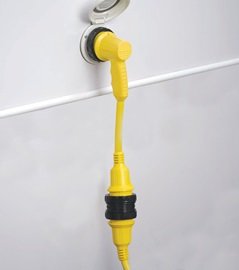Current flowing in a cable generates heat. This causes the temperature of the conductors to rise until the heat lost balances the heat generated. If the temperature gets too high the insulation on the cable softens and eventually melts.
When you pack lots of cables that are all carrying current (whether multiple seperate cables or multiple loops of the same cable) together heat dissipation suffers resulting in a higher temperature at a given current. This is most relevant to 50 amp connections.
Reels are particulally bad because they tightly pack together a large number of passes of the cable. Excess cable in a loose jumble on the ground is far less likely to overheat than excess cable wound tightly on a reel.
You get away with it most of the time because most of the loads people plug into leads are small and/or intermittent. From time to time though the right combination of circumstances come together and melts one. As we are talking about the propensity of boaters to overload, I still think that the coil-type should be extended fully.
Also, if you have an electrical code book, read the bit about multiple conductors and derating. That should give you an idea of the max current a given cable can carry.
I didn't watch the video so for my comments, it's irrelevant. Try and list all of services you are powering when you hook up shore power and remember that about 3000 watts is the continuous maximum:
Battery charger
Isolation transformer
Galvanic isolator
One or more heaters
Lights
Device chargers including wired USB ports
Alarm systems
Water heater
A/C
Freezers
Ice maker
Water pumps
Electric heads
Numerous kitchen appliances
Inverter
Electrical system monitors
There's more.
I would be willing to bet that a normally maintained shore power cable will perform as designed if its designed load is maintained. As soon as you exceed that parameter, you are putting yourself and others in peril.

